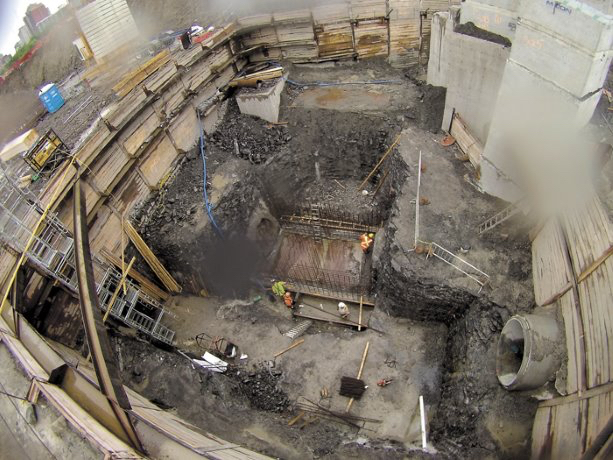
Overlapping opportunities uncovered as LRT Phase II connects with other projects and initiatives
The City of Ottawa has selected three consortiums to bid on the second phase of the Light Rail Transit (LRT) project, as it explores options to bundle the work with other infrastructure projects and seeks private sector inquiries for Station Oriented Development (SOD) projects at three and possibly four sites.
The result, as indicated by the linkages between the Combined Sewage Storage Tunnel Project (CSST) and the LRT work in the Booth St. area, may be situations where contractors could end up working on sites associated with one or more of their competitors’ projects.
To start, the Confederation Line East and West Extension short-list contract finalists specifically exclude the prime initial stage LRT contractor, the Rideau Transit Group (RTG), including instead:
-
Confederation Transit Group (CTG): Ferrovial, Colas and Tomlinson;
-
East West Connectors (EWC): Kiewit and Vinci; and,
-
Confederation Line 2 Partners (CL2P): Betchel, Aecon, Pomerleau and EBC.
The city says the contract awards are scheduled for the second quarter of 2018, with construction scheduled to start in spring 2019.
With federal and provincial support, the overall cost of the next phase of the rail line and add-ons is expected to cost $3.6 billion.
Vinci, Aecon and Colas all participated in unsuccessful bids for the initial rail contract. RTG and its members agreed to stay out of the bidding for the second phase, because their obvious advantage would suppress competition. The LRT will be extended east to Trim Rd. and west to Bayshore and Baseline by 2013.
However, RTG can participate in the bidding for the extension of the current O-Train (Trillium) line to Riverside South as well as a separate bidding opportunity to extend the current diesel train line to Bowesville, south of Ottawa’s airport.
Meanwhile, the city expects it may recover some additional funds through SOD projects at three sites (Cleary, Pinecrest and Baseline stations) and possibly an additional site at 1181 Richmond Rd.
The city issued a Request for Information (RFI) from developers on June 12.
“The city will evaluate these submissions and, if it is determined feasible, staff will recommend an approach to integrate the development of these sites as part of the implementation of the Confederation Line extensions,” city manager Steve Kanellakos said in a report to the mayor and council.
An earlier report by N. Barry Lyon Consultants explored the risks and challenges of SOD development initiatives, and suggested focusing on sites where the city owned/controlled the land, and could achieve political approval for the development buy-in. Undoubtedly, the private sector developers ultimately selected for the SOD opportunities may want to work either with the prime or subcontractors for the LRT work, or will chose their own construction teams.
See N. Barry Lyon Report: Preliminary Evaluation of SOD Opportunities Stage 2 LRT Expansion
In his June 19 memo, Kanellakos also said 23 other city projects have been “identified for bundling with the Stage 2 LRT procurement to benefit from the cost-compression and fixed price structure of the procurement model,” which he estimates has a value of approximately $120 million. Fourteen of the projects have been associated with the Confederation Line East and West extension and nine with the Trillium Line southern project.
“The project team is currently working with the appropriate city departments and corporate finance to finalize this list, which will be included in the appropriate procurement processes, Kanellakos writes.
These forward initiatives are taking place as significant integrations are associating the LRT work with the massive $232 million Combined Sewage Storage Tunnel (CSST) project.
The CSST project, which will store as much as 43,000 cu. m. of combined sewer outflow during severe wet weather, overlaps with the LRT project at the CSST’s Site 1.
According to a published report in Daily Commercial News, the CSST work near the LRT project includes:
-
An expanded Lebreton Flats diversion chamber underneath Booth St., south of the Booth St. Bridge, built to cross the new LRT line;
-
Doubling the existing chamber’s size, representing a main conjunction point, with four major sewer pipes feeding in and three pipes exiting;
-
The extraction chamber for the tunnel boring machine;
-
Open cut construction of the first 165 m. of the new CSST system; and
-
A new 3,000 mm. storm pipe, 112 m. long, crossing underneath the rail line.
The ownership structure and contractor relationships for the overlapping projects have resulted in some surprising relationships.
To start, the city provided the overall CSST project drawings to the Rideau Transit Group (the LRT contractor) and the subsidiary responsible for construction, Light Rapid Transit Constructors (ORLT-C) a joint venture of EllisDon, SNC-Lavalin Inc., Dragados Canada and ACS Infrastructure. Meanwhile, the overall CSST tunnel project was awarded to a joint venture between Dragados Canada and Tomlinson.
However, the Daily Commercial News reports that OLRT-C subcontracted its portion of the CSST work to Taggart Construction, one of Tomlinson’s competitors.
“It was a cash allowance project,” CSST program manager Steven Courtland has been quoted as saying. “It was separate from the LRT, but administered by RTG. Essentially, they tendered it and sent it out for bids. Taggart was the low bidder.”
There’ll be more overlapping (or perhaps more accurately, underlapping) project associations as the CSST project moves forward and the tunnel boring machine passes on its approach to the Site 1 LRT junction.
“It’s the new Ottawa Central Library,” Courtland said. “But that’s another story.”
